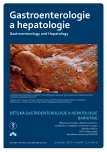Evaluation and applicability of nonbiopsy criteria in children and adolescents according to ESPGHAN for diagnosis of celiac disease
Authors:
J. Kabátová 1,2; R. Husťak 2,3; S. Blažíčková 2; V. Bošák 2
Authors‘ workplace:
Gastroenterologická ambulancia, Odborná detská ambulancia, s. r. o., Piešťany, Slovenská republika
1; Katedra laboratórnych vyšetrovacích metód v zdravotníctve, FZaSPTU v Trnave, Slovenská republika
2; 1. LF UK v Praze
3
Published in:
Gastroent Hepatol 2017; 71(6): 469-475
Category:
doi:
https://doi.org/10.14735/amgh2017csgh.info07
Overview
Summary:
The paper focuses on the analysis of anti-tissue transglutaminase 2 (anti-TG2) antibodies and endomysial antibodies (EMA) and HLA-DQ2/HLA-DQ8 haplotypes present in symptomatic children and adolescents with suspected coeliac disease. This refers to applying the new 2012 ESPGHAN criteria allowing to make the diagnosis of coeliac disease without an enterobiopsy. A total of 258 children and adolescents (86 males and 172 females), aged 2–18 years, were retrospectively examined to determine the performance of coeliac disease testing according to national guidelines from 2009. The obtained data were applied according to the revised 2012 ESPGHAN criteria allowing to make the diagnosis of coeliac disease in indicated cases without an anterobiopsy. The nonbiopsy criteria revealed that 33.3% (86) of symptomatic children and adolescents in our cohort with high anti-TG2 titers and positive EMA could have been initially diagnosed without an intestinal biopsy. All patients presented with advanced intestinal atrophy Marsh 2–3. Part of the rationale of the study was to determine the sensitivity and specificity, the positive and negative predictive values of the final laboratory tests, and the diagnostic accuracy of the combined tests using antibodies.
Key words:
coeliac disease – ESPGHAN – anti-TG2 – EMA – HLA-DQ2/HLA-DQ8
The authors declare they have no potential conflicts of interest concerning drugs, products, or services used in the study.
The Editorial Board declares that the manuscript met the ICMJE „uniform requirements“ for biomedical papers.
Submitted:
21. 3. 2017
Accepted:
24. 4. 2017
Sources
1. Husby S, Koletzko S, Korponay-Szabó et al. European Society for Pediatric Gastroenterology, Hepatology, and Nutrition guidelines for the diagnosis of coeliac disease. J Pediatr Gastroenterol Nutr 2012; 54 (1): 136–160. doi: 10.1097/ MPG.0b013 e31821a23d0.
2. Pekárková B, Pekárek B, Kabátová J. Štandardný diagnostický a terapeutický postup. 46. metodický list racionálnej farmakoterapie. Racionálna diagnostika a liečba celiakie 2009; 13 (1–2): 1–7.
3. Nevoral J, Kotalová R, Hradský O et al. Symptom positivity is essential for omitting biopsy in children with suspected celiac disease according to the new ESPGHAN guidelines. Eur J Pediatr 2014; 173 (4): 497–502. doi: 10.1007/s00431-013-2215-0.
4. Frühauf P, Bronský J, Dědek P et al. Celiakie – doporučený postup pro diagnostiku a terapii u dětí a dospívajících. Čes-slov Pediat 2016; 71 (3): 175–183.
5. Kubina M, Čierna I, Székyová D et al. Niektoré genetické determinanty celiakie, význam HLA typizácie v klinickej praxi a zastúpenie HLA-DQ haplotypov v súbore 306 detských pacientov. Gastroent Hepatol 2016; 70 (6): 475–479. doi: 10.14735/amgh2016475.
6. Smarrazzo A, Misak Z, Costa S et al. Diagnosis of celiac disease and applicability of ESPGHAN guidelines in Mediterranean countries: ad real life prospective study. BMC Gastroenterol 2017; 17 (1): 17. doi: 10.1186/s12876-017-0577-x.
7. Gidrewicz D, Potter K, Trevenen CL et al. Evaluation of the ESPGHAN Celiac Guidelines in a North American Pediatric Population. Am J Gastroenterol 2015; 110 (5): 760–767. doi: 10.1038/ajg. 2015.87.
8. International Organization for Standardization. ISO 15189 : 2012 Medical laboratiories – Requirements for quality and competence. [online]. Availabe from: www.iso.org/standard/56115.html.
Labels
Paediatric gastroenterology Gastroenterology and hepatology SurgeryArticle was published in
Gastroenterology and Hepatology

2017 Issue 6
- Metamizole vs. Tramadol in Postoperative Analgesia
- Metamizole at a Glance and in Practice – Effective Non-Opioid Analgesic for All Ages
- Possibilities of Using Metamizole in the Treatment of Acute Primary Headaches
- Metamizole in perioperative treatment in children under 14 years – results of a questionnaire survey from practice
- Obstacle Called Vasospasm: Which Solution Is Most Effective in Microsurgery and How to Pharmacologically Assist It?
Most read in this issue
- Cytomegalovirus infection and the liver
- Magnesium sulfate saline laxatives in the preparation for colonoscopy – our experience
- Epidemiology, hospitalization and migration of patients with IBD under specialized care in the Czech Republic
- Obesity and kidney
